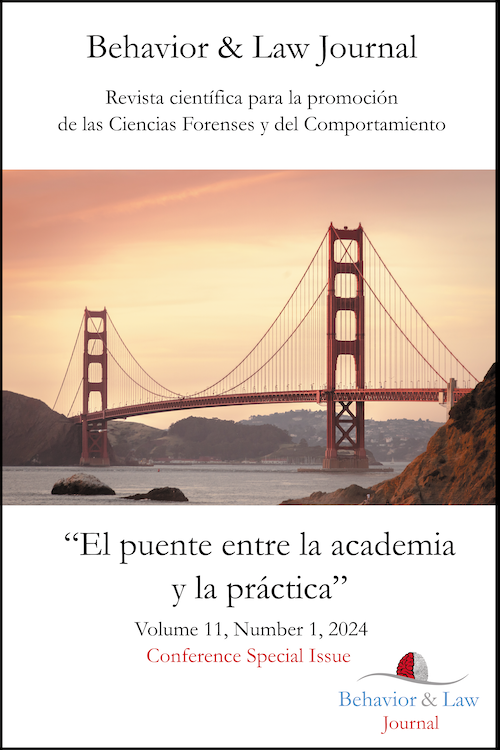Abstract
Stress affects the neurobiological functioning of human beings. Thus, the stress to which Security Forces and Corps (FFCCSE) are exposed could translate into inappropriate behaviours during their actions. They are trained to deal with threatening situations, but the accumulation of stressors could lead to behaviours
related to the Freeze, Fight & Flight theory (Cannon, 2015). These are reactions, physiological responses to an attack or danger sensed as a threat (Roelofs,
2017). The aim of this work is to investigate stressors by analysing differences according to gender, tenure in the corps, age and the organisation to which they
belong. The sample consisted of 170 participants (74.7% male), aged between 18 and 65 years, including Guardia Civil (27.1%); the 3 Armies (5.9%); Police (18.2%) and Security Guards (32.9%). The survey ‘Fight and Flight Therapy Test’ (Tessler, 2011) was used as well as a semi-structured Ad-hoc interview to analyse stressors. Participants exceeded acceptable levels of stress. Security officers showed more stress. Between 26 and 35 years of age, they show higher levels of stress. Anxiety is present in one third of the participants. All the professionals suffer frustrations due to decisions made by their managers. Between 6 and 15 years of experience, burn-out begins. The factors observed (inadequate rest, changes in circadian cycles, accumulation of stress due to daily confrontation with criminality, family and social pressures) can negatively affect an officer's responses, reacting by freezing, fleeing the scene or coping with a situation.
References
Andrés, M. (20 de Marzo de 2018). 17 horas sin dormir: límite al volante. Obtenido de El mundo: https://www.elmundo.es/comunidad-valenciana/castellon/2018/03/20/5ab15bb0e2704ee2308b4760.html
Artworth, A. (2012). Perceptual and memory distortion in officer involved shootings. FBI Law Enforcement Bulletin.
Ayash, S. e. (19 de junio de 2020). Stress inoculation in mice induces global resilience. Transl Psychiatry. www.nature.com. doi:https://doi.org/10.1038/s41398-020-00889-0
Berg, A., Hem, E., Lau, B., Haseth, K., & Ekeberg, O. (2005). Estrés en el servicio de policiá noruego. Occupational Medicine, 113-120.
Brufao, C. (1994). Una aproximación a las enfermedades profesionales de la policía. Revistas ucm, 254-262.
Cannon , W. B. (2015). Bodily Changes in Pain, Hunger, Fear and Rage: An Account of Recent Researches into the Function of Emotional Excitement. FQ Legacy Books.
CareerCast. (1 de julio de 2016). statista.com. Obtenido de https://es.statista.com/grafico/5196/que-trabajos-provocan-mas-estres
David, M., & Parker, K. (2007). Stress Inoculation-Induced Indications of Resilience in Monkeys. Standfor University.
Galanis, P., Fragkou, D., & Katsoulas, T. A. (12 de enero de 2019). Risk factors for stress among police officers, A systematic literature review. 1255-1278.
Gohar, A., Adams, A., Gertner, E., Sackett-Lundeen, L., Engle, R., & Heitz, R. e. (2009). La capacidad de la memoria de trabajo está disminuida en los residentes de medicina interna privados de sueño. Revista de Medicina Clínica del Sueño, 191-197.
Grossman, D., & Christensen, L. W. (2014). On combat: The psychology and Phisiology of Deadly Conflict in War and in Peace (1a ed.). (C. G. Marqués, Trad.) Melusina. Recuperado el 2022
Hall, J. C., Rosbash, M., & Youn, M. W. (5 de abril de 2022). National Institute of General Medical Sciences. Obtenido de https://www.nigms.nih.gov/education/fact-sheets/Pages/circadian-rhythms.aspx
Harley, T. A., Violanti, J. M., Sarkisian, K., Andrew , M. E., & Burchfiel, C. M. (2013). PTSD Hallsymptoms ammong police officers:associations with frecuency, recency and types of traumatic events. International Journal of Emergency Mental Health, 241-53.
Houdmont, J., & Randall, R. (2016). Working hours and common mental disorders in English police officers. Occupational Medicine, 713-718. Obtenido de https://academic.oup.com/occmed/article/66/9/713/2527579
Iqbal , S., & Kar, B. (15 de marzo de 2021). Nature. Obtenido de https://www.nature.com/articles/nindia.2021.39
Klopp, J. (5 de 2022). Neuro11. Obtenido de https://neuro11.de/category/neuro/
Kozlowska, K., Walker, P., McLean, L., & Carrive, P. (2015). Fear and the defense cascade: clinical implications and management. Harvard Review of Psychiatry, 263-297.
Lang, D., & Öhman, A. (2000). Fear and anxiety: Animal models and human cognitive psychophysiology. Journal of Affective Disorders, 61, 137-159.
Lazarus, R., & Folkman, S. (1986). Estreés y Procesos cognitivos. (M. Zaplana, Trad.) Barcelona: Martínez Roca, Barcelona.
Lyons, D., Parker, K., & Schatzberg, A. (2009). Cascadas de desarrollo que vinculan la inoculación del estrés, la regulación de la excitación y la resiliencia. Fronteras en la neurociencia conductual. Fronteras en la neurociencia conductual núm. 32.
Mercadillo, R. E., & Barrios, F. A. (2011). Brain Correlates of Impulsivity in Police Officers. The Open Criminology Journal, 54-60.
Ministerio del Interior. (21 de 9 de 2022). gob.es. Obtenido de https://www.interior.gob.es/opencms/es/detalle/articulo/La-Policia-Nacional-incorpora-galerias-de-tiro-virtuales-para-el-entrenamiento-de-sus-agentes/
O'Connor DB, T. J. (2021). Stress and Health: A Review of Psychobiological Processes. . Annu Rev Psychol, 663-688.
OMS. (2020). Occupational health: Stress at the workplace. OMS News. Obtenido de https://www.who.int/news/item/28-05-2019-burn-out-an-occupational-phenomenon-international-classification-of-diseases
Panksepp, J., Lane, R., Solms, M., & Smith, R. (2017). Reconciliación de las perspectivas de la neurociencia cognitiva y afectiva sobre la base cerebral de la experiencia emocional. Neurosci. biocomportamiento Rev., 187-215. doi:10.1126/j.neubiorev.2016.09.010
Police Violence. (s.f.). Amnesty International. Obtenido de https://www.amnesty.org/en/what-we-do/police-brutality/
Raine, A. (2013). The Anatomy of Violence: The Biological Roots of Crime. Vintage.
Rodriguez, I. (2019). Manual de Neurocriminología. Valencia: Planeta, VIU.
Roelofs, K. (2017). Freeze for action: Neurobiological mechanims animal and human freezing. The Royal Society Publishing.
Tessler, S. (2011). Flight or Fight Therapy. Obtenido de https://www.fightorflighttherapy.com/about
Velasco, P. (2022). Manual de Perfilación Criminal. Valecia : Planeta - VIU.
Vila, B. (2000). Tired cops: the importance of maging police fatigue. Whasington DC: Executive Research Forum.
Yager, J. (28 de abril de 2014). Why Do We Procrastinate? NEJM Journal Watch.Psychiatry. Obtenido de https://www.proquest.com/scholarly-journals/why-do-we-procrastinate/docview/1519494494/se-2

This work is licensed under a Creative Commons Attribution-NonCommercial-NoDerivatives 4.0 International License.
Copyright (c) 2025 Behavior & Law Journal
